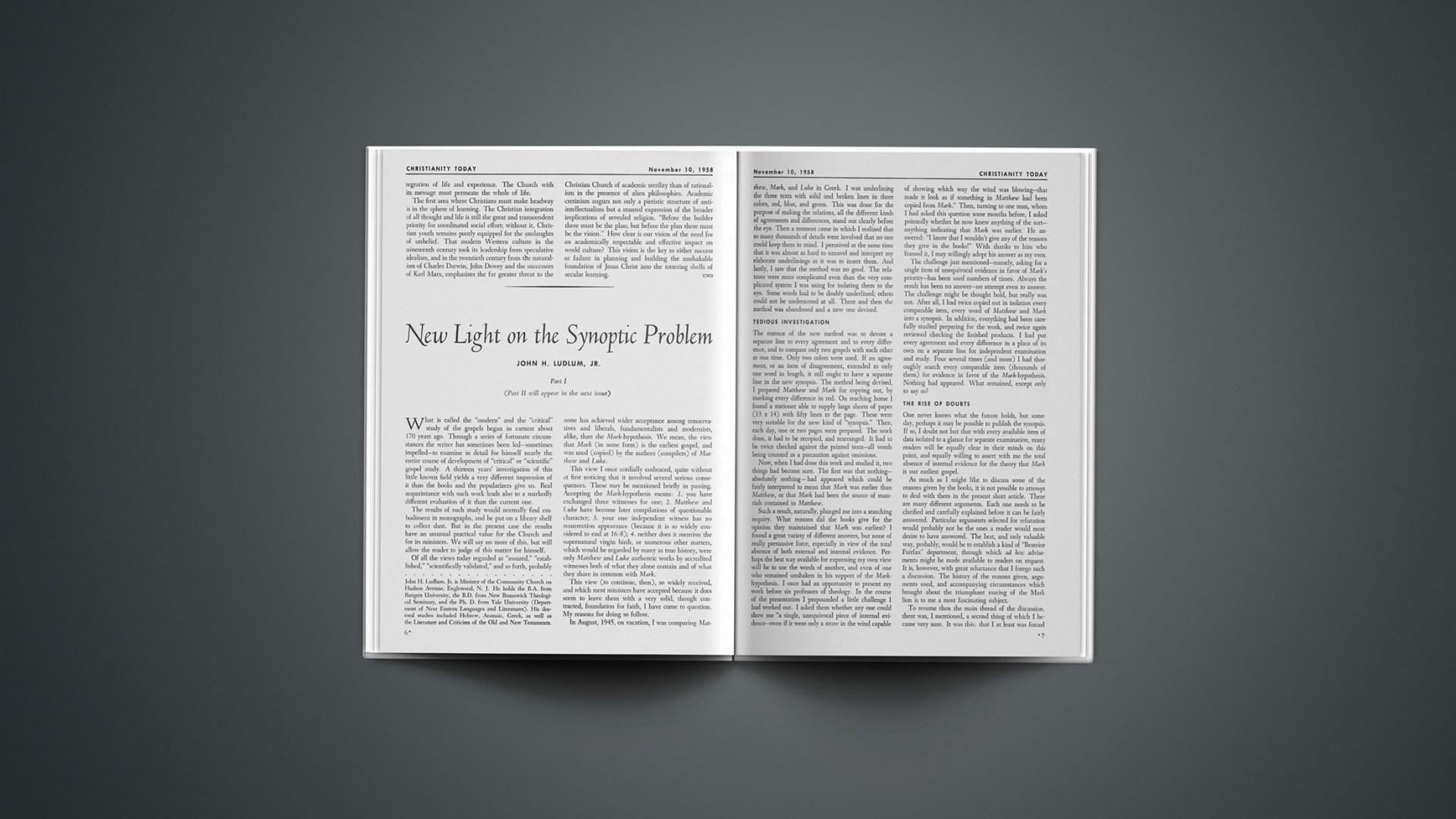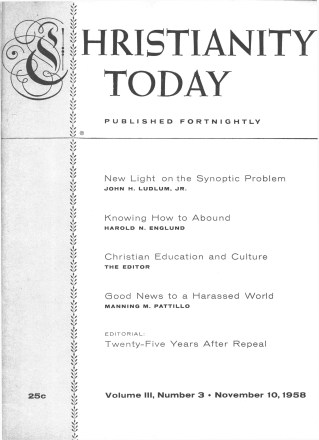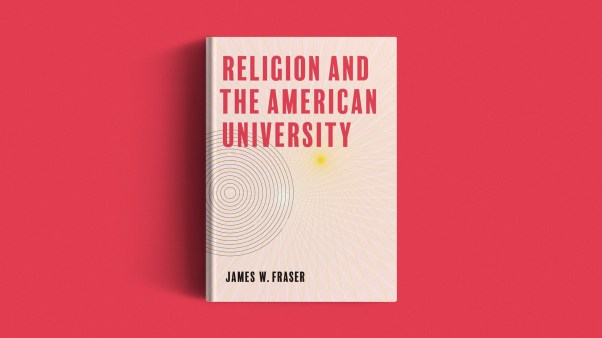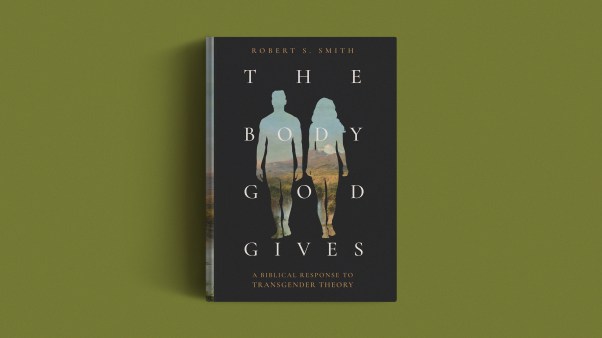(Part II will appear in the next issue)
What is called the “modern” and the “critical” study of the gospels began in earnest about 170 years ago. Through a series of fortunate circumstances the writer has sometimes been led—sometimes impelled—to examine in detail for himself nearly the entire course of development of “critical” or “scientific” gospel study. A thirteen years’ investigation of this little known field yields a very different impression of it than the books and the popularizers give us. Real acquaintance with such work leads also to a markedly different evaluation of it than the current one.
The results of such study would normally find embodiment in monographs, and be put on a library shelf to collect dust. But in the present case the results have an unusual practical value for the Church and for its ministers. We will say no more of this, but will allow the reader to judge of this matter for himself.
Of all the views today regarded as “assured,” “established,” “scientifically validated,” and so forth, probably none has achieved wider acceptance among conservatives and liberals, fundamentalists and modernists, alike, than the Mark-hypothesis. We mean, the view that Mark (in some form) is the earliest gospel, and was used (copied) by the authors (compilers) of Matthew and Luke.
This view I once cordially embraced, quite without at first noticing that it involved several serious consequences. These may be mentioned briefly in passing. Accepting the Mark-hypothesis means: 1. you have exchanged three witnesses for one; 2. Matthew and Luke have become later compilations of questionable character; 3. your one independent witness has no resurrection appearance (because it is so widely considered to end at 16:8); 4. neither does it mention the supernatural virgin birth, or numerous other matters, which would be regarded by many as true history, were only Matthew and Luke authentic works by accredited witnesses both of what they alone contain and of what they share in common with Mark.
This view (to continue, then), so widely received, and which most ministers have accepted because it does seem to leave them with a very solid, though contracted, foundation for faith, I have come to question. My reasons for doing so follow.
In August, 1945, on vacation, I was comparing Matthew, Mark, and Luke in Greek. I was underlining the three texts with solid and broken lines in three colors, red, blue, and green. This was done for the purpose of making the relations, all the different kinds of agreements and differences, stand out clearly before the eye. Then a moment came in which I realized that so many thousands of details were involved that no one could keep them in mind. I perceived at the same time that it was almost as hard to unravel and interpret my elaborate underlinings as it was to insert them. And lastly, I saw that the method was no good. The relations were more complicated even than the very complicated system I was using for isolating them to the eye. Some words had to be doubly underlined; others could not be underscored at all. There and then the method was abandoned and a new one devised.
Tedious Investigation
The essence of the new method was to devote a separate line to every agreement and to every difference, and to compare only two gospels with each other at one time. Only two colors were used. If an agreement, or an item of disagreement, extended to only one word in length, it still ought to have a separate line in the new synopsis. The method being devised, I prepared Matthew and Mark for copying out, by marking every difference in red. On reaching home I found a stationer able to supply large sheets of paper (13 × 14) with fifty lines to the page. These were very suitable for the new kind of “synopsis.” Then, each day, one or two pages were prepared. The work done, it had to be recopied, and rearranged. It had to be twice checked against the printed texts—all words being counted as a precaution against omissions.
Now, when I had done this work and studied it, two things had become sure. The first was that nothing—absolutely nothing—had appeared which could be fairly interpreted to mean that Mark was earlier than Matthew, or that Mark had been the source of materials contained in Matthew.
Such a result, naturally, plunged me into a searching inquiry. What reasons did the books give for the opinion they maintained that Mark was earliest? I found a great variety of different answers, but none of really persuasive force, especially in view of the total absence of both external and internal evidence. Perhaps the best way available for expressing my own view will be to use the words of another, and even of one who remained unshaken in his support of the Mark-hypothesis. I once had an opportunity to present my work before six professors of theology. In the course of the presentation I propounded a little challenge I had worked out. I asked them whether any one could show me “a single, unequivocal piece of internal evidence—even if it were only a straw in the wind capable of showing which way the wind was blowing—that made it look as if something in Matthew had been copied from Mark.” Then, turning to one man, whom I had asked this question some months before, I asked pointedly whether he now knew anything of the sort—anything indicating that Mark was earlier. He answered: “I know that I wouldn’t give any of the reasons they give in the books!” With thanks to him who framed it, I may willingly adopt his answer as my own.
The challenge just mentioned—namely, asking for a single item of unequivocal evidence in favor of Mark’s priority—has been used numbers of times. Always the result has been no answer—no attempt even to answer. The challenge might be thought bold, but really was not. After all, I had twice copied out in isolation every comparable item, every word of Matthew and Mark into a synopsis. In addition, everything had been carefully studied preparing for the work, and twice again reviewed checking the finished products. I had put every agreement and every difference in a place of its own on a separate line for independent examination and study. Four several times (and more) I had thoroughly search every comparable item (thousands of them) for evidence in favor of the Mark-hypothesis. Nothing had appeared. What remained, except only to say so?
The Rise Of Doubts
One never knows what the future holds, but someday, perhaps it may be possible to publish the synopsis. If so, I doubt not but that with every available item of data isolated to a glance for separate examination, many readers will be equally clear in their minds on this point, and equally willing to assert with me the total absence of internal evidence for the theory that Mark is our earliest gospel.
As much as I might like to discuss some of the reasons given by the books, it is not possible to attempt to deal with them in the present short article. There are many different arguments. Each one needs to be clarified and carefully explained before it can be fairly answered. Particular arguments selected for refutation would probably not be the ones a reader would most desire to have answered. The best, and only valuable way, probably, would be to establish a kind of “Beatrice Fairfax” department, through which ad hoc advisements might be made available to readers on request. It is, however, with great reluctance that I forego such a discussion. The history of the reasons given, arguments used, and accompanying circumstances which brought about the triumphant roaring of the Mark lion is to me a most fascinating subject.
To resume then the main thread of the discussion, there was, I mentioned, a second thing of which I became very sure. It was this: that I at least was forced both to question and to reject the most important single assumption underlying over 150 years of gospel study. That basic assumption, which nearly everyone seemed to regard as unquestionable, is usually called “direct literary dependence.” In plain language this means “word-for-word copying.” The assumption, indeed, was as every one knows, a vital part (viz., the foundation) of the theory that Mark is our earliest gospel. Mark is held to have been the primary source utilized by those who compiled Matthew and Luke.
Weighing The Agreements
My principal reason for questioning, and rejecting, so basic an assumption lay in the fact that my synopsis had isolated all the differences and all the agreements for repeated examination. Especially was I able to examine and weigh all the exact agreements. The quantity and quality of these must ever be the only solid, indeed, the only possible foundation for a theory of direct literary dependence (i.e., of copying). These exact agreements seemed in no way capable, in my judgment, of convincing any fair-minded critic of direct literary dependence. The facts are as follows: 1. Matthew and Mark, when put in parallel columns, agree exactly at 1,877 places; 2. exact agreements vary in length from places one word only in length to one place 29 words long; 3. the average length of all places in exact agreement is 2.43 words; 4. the number of places where Matthew and Mark are found agreeing for ten words, or more, in succession is 38 (just barely over 2.0% of the 1,877 places showing exact agreements). I have discussed these agreements at considerable length in a privately published set of worksheets, as well as fantastic claims “that 90% of Mark is transcribed in Matthew,” and so forth. Here limitations of space require that my result be simply stated without elucidation. And therefore, thus far, the principal reason for my personal secession from the camp of the advocates of direct literary dependence.
There was a second reason for it, however, and one which, if I judge correctly, will prove to candid minds fully as weighty, if not more so, than any considerations hitherto presented, or the elucidation of them, which has not been presented. It happened, quite by accident, as I was putting the synopsis of Matthew and Mark into shape, that I discovered the existence of an amazingly similar batch of phenomena elsewhere. And I cannot find that anyone else has ever thought of bringing the phenomena I refer to into comparison with what the gospels show. I mean, what is found in certain texts of the Greek Old Testament (Septuagint). I stumbled on the two texts of Judges (designated A and B) which Rahlfs prints, one above the other, in his manual edition of the Septuagint.
Once discovered, it was the work of but a few hours, with the whole range of gospel phenomena clearly in mind, to ascertain that the phenomena (both the agreements and differences) presented by the two divergent Greek texts of Judges were so astonishingly like those shown in the comparison of Matthew and Mark, that they must be carefully elicited, isolated, and studied for any light they might have to throw on a developing critique of the dominant critical opinions in reference to the gospels.
The study was no sooner conceived than its execution began. At once an added incentive to complete it appeared. A quick look-around had shown that Oesterley and Robinson, Grabe, Lagarde, Moore, and Budde had maintained that the manuscripts A and B, the two oldest Greek texts of Judges, represented two independent translations from Hebrew. Theirs seemed to be (and, I think is) the dominant scholarly view. The meaning of this will be obvious. Here we have, on the one hand, a dominant critical view of the gospels based on an unquestioned assumption that one specific collection of exact agreements in Greek proved direct, Greek-on-Greek literary dependence. The matter of a specific language is an important point to watch. In plain parlance it may be put this way.
Scholars claimed that a body of exact agreements in Greek proved that two of our first three gospels were written in Greek by compilers, who copied their materials from a source (Mark) written in Greek. But, on the other hand, we have another group of scholars claiming that a larger quantity (as it proved, and also of longer average length) of exact agreements in Greek offered no obstacle to their view that two texts were independently made translations from Hebrew originals. That is, they held that the exact agreements in Greek were due to chance.
The contrast then, briefly, was this. “So much exact agreement in two Greek texts proves copying from a Greek document,” said the New Testament scholars. “Twice as much as you have,” reply the Old Testament scholars, “would still not prove any such thing”! The matter assuredly called for careful investigation.
Text Of Judges
I therefore set to work on a synopsis of the A and B texts of Judges. The parallel layout in this case was exactly the same as that used for the gospels. A separate line (or group of lines) was devoted to every individual exact agreement, as well as to every disagreement. It thus proved feasible to institute a full scale comparison of the A and B texts of Judges with the Matthew and Mark texts of the gospels. The result was illuminating. So similar were the two sets of materials that the validity of the assumption of copying in Greek seemed completely impugned. Still, careful analysis made it clear that the two sets of data were sufficiently different so as not to compel any one to think that both gospels had used a common Hebrew (Aramaic) source. The outcome was that I have been led not merely to question, but to reject as a non-sequitur the very view which nearly all New Testament scholars are quite prone to receive as the alpha and the omega of any respectable criticism.
This result was later confirmed when it became possible to devote an entire doctoral thesis to an attempt to determine the relation of the texts of Judges in codices A and B to each other. Above two and one-half years were spent in an effort to learn whether the two texts of Judges arose from copying in Greek (two recensions from an earlier Greek text); or, whether they ultimately went back to two independently executed translations from Hebrew originals, and so had their Greek agreements by chance. The result of a thorough investigation was entirely in favor of the view of the Old Testament scholars. It appeared very clear that the extensive exact agreements in Greek might easily have been, and probably in fact were, a fortuitous result of independent attempts to translate into Greek two very nearly identical Hebrew texts. The conclusion reached powerfully confirmed the decisions to question and to reject the most basic tenet of New Testament criticism.
Which view of these exact agreements, then, is right? or, which is most nearly so? It is not possible to go further into the matter at present. Enough has been said, however, to make it abundantly plain why the writer was led on to investigate carefully the entire history of “modern” “critical” study of the gospels. The questions raised were so basic, that should it prove feasible to establish their validity, no one could foresee what the result might prove to be for the future of scientific study of the gospels. Moreover, a way seemed clearly to be opening up, and that a genuinely scholarly and scientific way, whereby the gospels might be reinstated as authentic compositions of Matthew (the publican), Mark (Peter’s interpreter), and Luke (Paul’s companion); reliable, primary, historical sources; three independently attested accounts of Jesus’ words and deeds. In pursuing studies of the actual history of criticism I discovered that the scholarly writers involved had a much saner doubt of the value of their work and of its sureness, than do they of another generation, who build the tombs of the scholars.
The article to follow this will give a comprehensive picture of the development of critical gospel study. I may warn the reader, also. This work obtains two opposite reactions. Some (and they churchmen!) are revulsed because they think it an attempt to set back the clock. Others welcome it. To them it seems rather to be a clearing away of debris: finding a “treasure hid in a field.”
END
John H. Ludlum, Jr, is Minister of the Community Church on Hudson Avenue, Englewood, N. J. He holds the B.A. from Rutgers University, the B.D. from New Brunswick Theological Seminary, and the Ph. D. from Yale University (Department of Near Eastern Languages and Literatures). His doctoral studies included Hebrew, Aramaic, Greek, as well as the Literature and Criticism of the Old and New Testaments.










